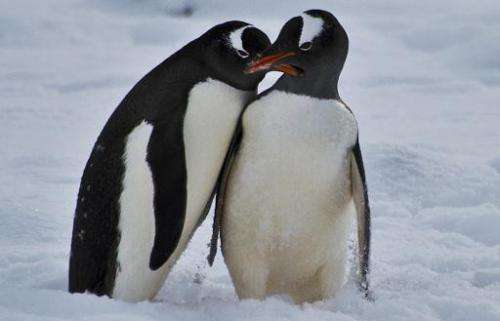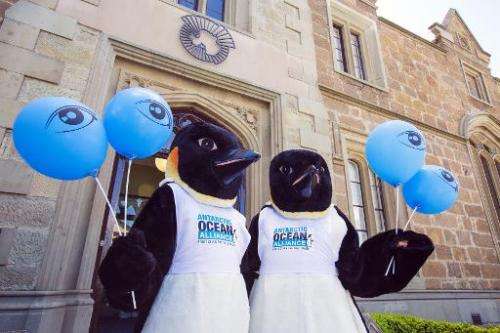Penguins pictured on King George island in Antarctica, on March 13, 2014. Australia hopes to win support for its plan to create a vast marine sanctuary plan off Antarctica
Australia said Monday it was hopeful of winning support for its plan to create a vast marine reserve off Antarctica, after revising the proposal to make it smaller.
Australia, France and the European Union first put forward a bid for a 1.9 million square kilometre (760,000 square mile) Marine Protected Area (MPA) encompassing seven stretches of the pristine wilderness in 2011, but it was knocked back last year.
Its latest proposal is for a 1.0 million square kilometre zone over four areas, a plan which will be considered at the annual Commission for the Conservation of Antarctic Marine Living Resources (CCAMLR) talks in Hobart beginning Monday.
"The reduction in the scale of the East Antarctic proposal reflects concerns from some nations that the area included was too large," said the head of Australia's delegation Tony Fleming.
"We are looking forward to working with other nations to reach a good outcome on marine protected areas at this year's meeting," he said in a statement.
Fleming, who is director of the Australian Antarctic Division, said the changes would allow for some fishing and research in the marine protected areas as long as conservation values were met.
Last year's CCAMLR talks failed to approve the East Antarctica sanctuary, on the frozen continent's Indian Ocean side, as well as a US-New Zealand bid for a protected zone in the Ross Sea, after Russia and China blocked them.
Fleming refused to elaborate on the reasons for the objections, including whether they related to concerns about fishing or exploration, beyond saying some members had baulked at the size of the east Antarctica bid.
File photo shows environmental activists rallying in Hobart, Australia in October 2013 to call for permanent Antarctic marine protection
"We've listened to those concerns," he told reporters in Hobart.
He said whether the compromise was sufficient to get the plan over the line would depend on "the atmosphere" of the meeting, adding that there had been "positive informal discussions" with Russia and other members.
"The negotiations at this year's CCAMLR meeting are critical. I don't know whether the proposal will succeed but we will work with all members," he said.
Fleming added that he was confident the proposal would adequately protect representative areas of biodiversity, including those vulnerable to disturbance and those which play an important ecological role.
"The benefits of the proposal are to protect biodiversity in the region and to protect foraging areas for marine mammals and penguins and spawning areas for toothfish and krill," he said.
"The benefit of the proposal is to protect the ecosystem processes as well."
Australia continues to support the US-New Zealand proposal for a sanctuary on the Ross Sea, the deep bay on Antarctica's Pacific side, he said.
Last year that proposal had been considered the best hope of succeeding after it was reduced, with its no-fish zone to be 1.25 million square kilometres. However, it failed to the win the support of all 25 members of CCAMLR needed to be passed.
Bob Zuur, manager of the World Wildlife Fund's Antarctica program, said it was crucial to protect an area so "critical for scientific research."
"Antarctica is one of the world's last untouched wildernesses. It's the barometer of the health of the planet. There is little doubt that countless other species are yet to be discovered," he told a press conference in Paris.
"But for us to continue research, we are responsible for the protection of this ecosystem. CCAMLR has an opportunity to do just that, through the designation of MPAs."
CCAMLR is a treaty tasked with overseeing conservation and sustainable exploitation of the Antarctic Ocean, also known as the Southern Ocean.
© 2014 AFP
























